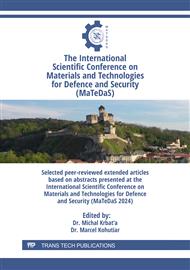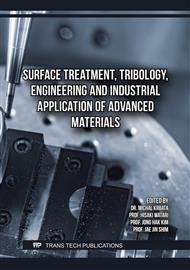p.3
p.9
p.17
p.27
p.41
p.57
p.65
p.73
p.85
Exploring the Influence of Variations in Distance Levels to Dielectric Barrier Discharge Plasma on Surface Energy and Fluorescence Modifications in Shape-Stable Aluminum Alloys and Shape-Instable Unvulcanized Rubber Blends
Abstract:
The growing demand for advanced materials with enhanced surface properties has driven significant research into various surface modification techniques. Among these, plasma treatment emerges as a versatile and effective method for improving the characteristics of different materials [1-10]. Plasma technology offers unique benefits, such as the ability to modify surfaces without the need for harsh chemicals or excessive energy inputs. This study focuses on two specific materials: Aluminum alloy 2024, recognized for its high strength-to-weight ratio, excellent corrosion resistance, and widespread application in aerospace and automotive industries, and unvulcanized rubber compounds, which provide flexibility and resilience essential for various applications, including seals and gaskets. Utilizing dielectric barrier discharge (DCSBD) technology for surface modification presents a novel approach to activating and cleaning the surfaces of these materials [11,12]. DCSBD plasma operates at atmospheric pressure, making it a cost-effective alternative to traditional cleaning and activation methods that often rely on corrosive chemicals or mechanical abrasion. The versatility of DCSBD plasma allows for fine-tuning of various parameters, such as voltage, treatment time, and gas composition, enabling tailored modifications to achieve desired surface properties. This research aims to investigate the effects of plasma application on Aluminum alloy 2024, particularly in terms of enhancing surface energy and wettability. Increasing surface energy is critical for improving adhesion properties, particularly for applications that involve coating or bonding processes [13]. The plasma treatment process results in enhanced surface energy, significantly reducing the contact angle of testing liquids on treated surfaces compared to their untreated counterparts. This enhanced wettability can lead to improved adhesive bonding and overall performance of coated or bonded materials [14-17]. The study evaluates how variations in treatment parameters such as voltage, exposure time, and airflow rate affect the surface properties of both materials. Furthermore, the impact of varying distances between the plasma source and the treated surfaces is examined, as this distance significantly influences the efficacy of the surface modification process. Understanding the relationship between these variables is essential for optimizing plasma treatment conditions. Previous studies have highlighted the potential of plasma treatment to improve the adhesion of coatings to Aluminum alloy 2024 [18-20]. This research asserts that atmospheric pressure plasmas provide a compelling alternative to conventional surface preparation techniques, such as acid etching or mechanical abrasion, which can be harmful to both the environment and the materials being treated. Moreover, the comparative surface modification effects on the two distinct materials: shape-stable Aluminum alloy 2024 and shape-unstable unvulcanized rubber offer valuable insights into the plasma treatment process. The findings from this research are expected to elucidate the intricate relationship between plasma treatment parameters and the resulting surface characteristics. By systematically varying the distance between the plasma source and the material surfaces, this study aims to identify optimal conditions for effective surface modification. Ultimately, this research contributes to a better understanding of plasma technology's capabilities, paving the way for enhanced applications across various industries. Experimental data suggest that the plasma process significantly reduces contaminants and enhances the alloy’s wettability. Another study examined how plasma treatment can improve the adhesion of paint films by pre-treating Aluminum 2024 surfaces. To improve adhesive bonding on Aluminum 2024, further research demonstrated that atmospheric-pressure plasmas offer a viable alternative to acid treatments or abrasive techniques for preparing surfaces before bonding [18]. Exposure times for Aluminum 2024 surfaces differ based on the plasma-generating device; one study applied exposure times from 1 to 10 seconds at 330 [W] using a DCSBD system [21]. Another essential factor in plasma-based surface modification is the material-to-plasma distance, as seen in research where wood surfaces were exposed to plasma for 10 seconds with spacers to control the separation distance at 0.15 [mm], 0.45 [mm], and 1 [mm] [22]. Comparable studies using DCSBD plasma technology at 400 W applied exposure times from 5 to 60 seconds, under varying atmospheric gases such as O₂, CO₂, N₂, and Ar, with separation distances from 0.1 to 0.2 [mm] [23]. This work aims to investigate the potential of DCSBD plasma to treat flat materials, specifically Aluminum 2024 alloy and unvulcanized rubber compound (UnRB). The study seeks to compare plasma’s surface modification effects on shape-stable (AA2024) and shape-unstable (UnRB) flat materials. Prior studies have shown that adjusting the distance between the plasma source and the surface significantly impacts surface energy and cleanliness. Here, we focus on evaluating how distance influences the effectiveness of plasma surface modification on AA2024 and UnRB, aiming to determine the maximum distance at which effective surface modification can be achieved. Evidence of plasma efficacy includes a notable increase in surface energy and fluorescence changes, clear indicators of the plasma’s cleaning effect. Given that UnRB is less dimensionally stable than aluminum alloy, comparing these materials at varying distances from the plasma source offers fresh insights into how different surfaces respond to plasma treatment. The findings simulate conditions where materials are at various distances from the plasma-generating ceramic dielectric, providing deeper understanding of plasma’s cleaning and energy effects on different surface types.
Info:
Periodical:
Pages:
41-56
Citation:
Online since:
June 2025
Keywords:
Price:
Сopyright:
© 2025 Trans Tech Publications Ltd. All Rights Reserved
Share:
Citation:



